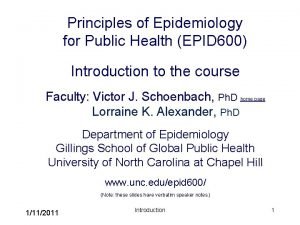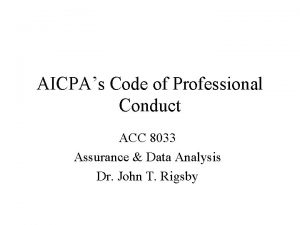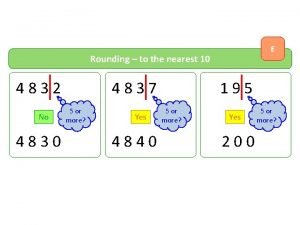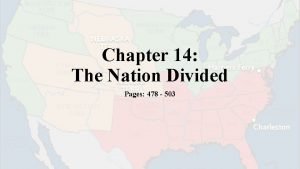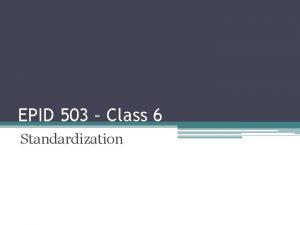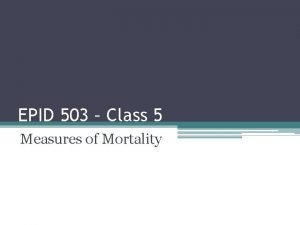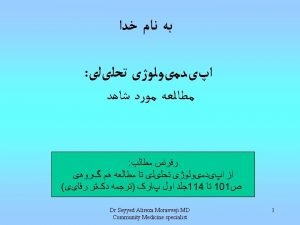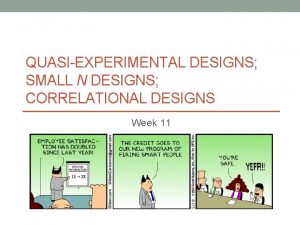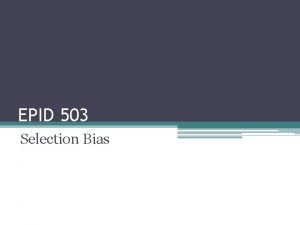EPID 503 Class 14 CrossSectional Studies Study Designs
























- Slides: 24

EPID 503 – Class 14 Cross-Sectional Studies

Study Designs • Randomized Trials Establish Causality • Cohort Studies • Case Control Studies • Cross-Sectional Studies • Ecologic Studies Generate Hypotheses

Cross-Sectional and Ecologic Studies • Snap-shot of population(s) at a single point in time • Participants selected without regard to exposure or disease status • Describes the relationship between exposure and outcome at a single point in time

Cross-Sectional Studies • May collect data for every person in a population or • May sample a segment of the population (the most common approach)

Measures of Association Outcome YES Outcome NO Exposed YES a b Exposed NO c d Prevalence Ratio = a/(a+b) / c/(c+d) Prevalence Odds Ratio = (a/b)/(c/d) or (a/c)/(b/d) = ad/bc

Prevalence Odds Ratio vs Prevalence Ratio Outcome YES Outcome NO Exposed YES a b Exposed NO c d When disease is rare a/(a+b) c/(c+d) ~ a/b c/d When disease is not rare, odds ratio will overestimate the prevalence ratio

Prevalence Ratio vs. Relative Risk Iexp Punexp = Iunexp dexp x dunexp

Strengths & Limitations Cross-Sectional Study Strengths • Good for generating hypotheses. • Often efficient, less time consuming, and costly than other designs. • Temporality will not be a problem for time invariant exposures (genetic markers). Cross-Sectional Study Limitations • Often problems of sorting out temporality – did the exposure or disease happen first? • Prevalent cases may not be same as incident cases. • Not useful for rare diseases or exposures.

Ecologic Studies • Study using populations or groups of individuals as units of observation. • The unit of analysis: Group • Important characteristic of ecologic studies is that the level of exposure and outcome for each individual in the unit being studied is unknown ▫ All other designs discussed use individual person as unit of analysis.

Examples of Ecologic Data • Aggregate measures summarizing the mean characteristics of a group of individuals (e. g. rate of a given disease, average amount of fat intake, proportion of smokers, median income) • Environmental measures that represent the average physical characteristics for the group of interest (e. g. , average air pollution in a city, hours of sunlight, neighborhood socioeconomic status) • Global measures that are inherently a group measure and do not have analogues at the individual level (e. g. , type of political or health care system, a certain regulation or law, and the presence and magnitude of health inequalities)

Ecologic Correlation of Breast Cancer Mortality and Dietary Fat Intake Age-Adjusted Death Rate/100, 000 Population 25 Netherlands UK Canada 20 Ireland Australia Sweden Germany Norway. France Austria Italy 15 Switzerland Belgium US Denmark New Zealand Czechoslovakia Portugal 10 Hungary Finland Poland Hong Kong Chile Bulgaria Venezuela Romania Panama Yugoslavia 5 Spain Greece Columbia Philippines Mexico Japan Taiwan Thailand 0 0 20 Ceylon El Salvador 40 60 80 100 120 140 160 180 Total Dietary Fat Intake (g/day) Correlation between dietary fat intake and breast cancer mortality by country. (Prentice, Kakar, Hursting et al: Aspects of the rationale for the Women’s Health Trial. J. Nat’l Cancer Inst. 80: 802 -814, 1988). Cited by Gordis, p. 169

Ecologic Fallacy • Inference about from group measures may not represent individual level patterns accurately • Provinces with greater proportions of Protestants had higher suicide rates than Catholic provinces in France • May be that Catholics have higher suicide rates in these areas due to stress of being the religious minority

Strengths & Limitations: Useful with Caution Ecologic Study Strengths • Data is relatively easy and/or cheap to obtain. • Good place to start. • Many relevant social, occupational and environmental exposures cannot be ascribed to an individual. Ecologic Study Limitations • Reliance on grouplevel data may not correctly represent individual-level associations. 13

Study Designs • Randomized Trials Establish Causality • Cohort Studies • Case Control Studies • Cross-Sectional Studies • Ecologic Studies Generate Hypotheses

What Makes Some Designs Better than Others? IDEAL SCENARIO • Exposure unrelated to personal characteristics (exposed and unexposed exactly alike except for exposure) • Follow for new disease over time

What Makes Some Designs Better than Others? IDEAL SCENARIO • Exposure unrelated to personal characteristics (exposed and unexposed exactly alike except for exposure) • Follow for new disease over time What design has this?

What Makes Some Designs Better than Others? IDEAL SCENARIO • Exposure unrelated to personal characteristics (exposed and unexposed exactly alike except for exposure) • Follow for new disease over time Which designs have this?

What Makes Some Designs Better than Others? What’s the implication of this? PRACTICAL ISSUES • Exposure can be very bad or very good for you

What Makes Some Designs Better than Others? What design helps us here? PRACTICAL ISSUES • Exposure can be very bad or very good for you • Disease can be too rare to follow for new cases

What Makes Some Designs Better than Others? And here? PRACTICAL ISSUES • Exposure can be very bad or very good for you • Disease can be too rare to follow for new cases • Latency period can be too long to allow tracking of new cases

What Makes Some Designs Better than Others? Which designs are cheaper? PRACTICAL ISSUES • Exposure can be very bad or very good for you • Disease can be too rare to follow for new cases • Latency period can be too long to allow tracking of new cases • $$$ is always limited

Extra Slides for You

Design RCT Cohort Begin by randomly assigning “healthy” people to exposure or none Begin with “healthy” exposed and unexposed Follow-up for newly developed outcome Randomization of exposure Yes Casecontrol Crosssectional Begin with sample of population cases and sample controls Follow-up for Obtain Crossnewly information classify by developed on exposure outcome and outcome No No No

RCT Measure of Disease Frequency Cohort Casecontrol Incidence Odds of (cumulative exposure incidence or incidence rate) Crosssectional Prevalence (also odds of disease) Groups being compared Exposed and unexposed Cases and controls Exposed and unexposed Measure of Association Risk or rate ratio Odds ratio Prevalence ratio (Also odds ratio) (also odds of disease) (Also odds ratio)
 Epid 600 unc
Epid 600 unc Crack comparator card
Crack comparator card Cpsc 503
Cpsc 503 Nacr-503
Nacr-503 What is immediate family considered
What is immediate family considered Humiseal 503
Humiseal 503 Champion equality diversity and inclusion
Champion equality diversity and inclusion 4837 to the nearest 100
4837 to the nearest 100 Heamop
Heamop 2 687 in scientific notation
2 687 in scientific notation H 503
H 503 503 divided by 3
503 divided by 3 Vce study designs
Vce study designs Classification of study designs
Classification of study designs Paradigm shift from women studies to gender studies
Paradigm shift from women studies to gender studies Outdoor and environmental studies
Outdoor and environmental studies Legal studies study design
Legal studies study design Vce theatre studies study design
Vce theatre studies study design Ecological study vs cohort study
Ecological study vs cohort study Retrospective cohort study vs prospective cohort study
Retrospective cohort study vs prospective cohort study Method study in management
Method study in management Marty lobdell
Marty lobdell Phytogeographical regions of world
Phytogeographical regions of world Differentiate between time study and motion study
Differentiate between time study and motion study Time and motion study example ppt
Time and motion study example ppt
